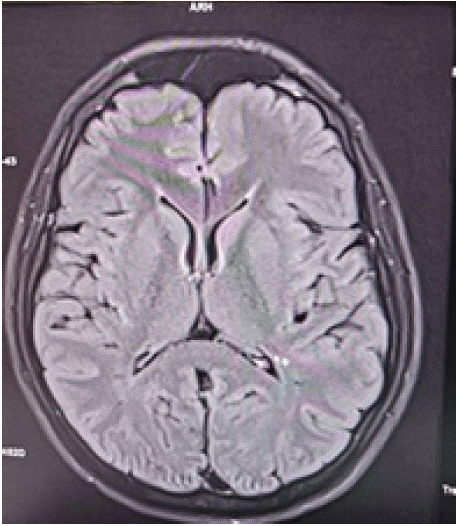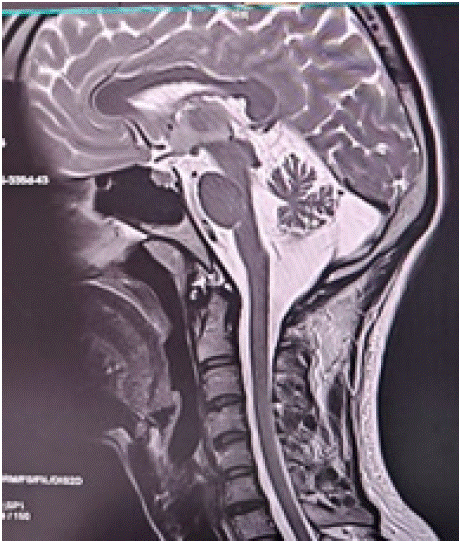
Case Report
Austin J Neurol Disord Epilepsy. 2025; 11(1): 1056.
Genetically Proved Hereditary Spastic Paraplegia – A Case Report
Rajeev A1* and Kumar P2
1Department of Psychiatry, ACSR GMC, Nellore, Andhra Pradesh, India
2Department of Neurology, ACSR GMC, Nellore, Andhra Pradesh, India
*Corresponding author: Abhirami Rajeev, Department of Psychiatry, ACSR GMC, Nellore, Andhra Pradesh, India Email: abhiramirajeevqln@gmail.com
Received: January 16, 2025; Accepted: January 31, 2025 Published: February 04, 2025
Abstract
To report a patient with Hereditary Spastic Paraplegia (HSP), with Ear of Lynx sign on MRI Brain and with genetic sampling showing SPG 28 (OMIM#609340) with a novel mutation and to hypothesize the possible relationship between the radiological finding with the disease and novel gene mutation of DDHD1(- ) (ENST00000673822.2) Exon 1, Variant c.306C>G (p.Tyr102Ter). Clinical, radiological and genetic report of a 55 year old patient with complaints of progressive lower limb weakness were described. This present case highlights the importance of novel gene mutation associated with Ear of Lynx sign on MRI, which is usually seen in SPG 11.
Keywords: Hereditary Spastic Paraplegia; Ear of Lynx; SPG 28
Introduction
• The hereditary spastic paraplegias (HSPs) are a heterogeneous group of monogenic neurological diseases with a combined prevalence of two to five cases per 100 000 individuals worldwide [1,2].
• They are characterised by length-dependent corticospinal tract and dorsal column degeneration that manifests with the core clinical features of bilateral lower limb spasticity, hyperreflexia, and extensor plantar responses [3].
• HSPs can present in infancy, childhood, adolescence, or adulthood.
• Autosomal dominant, autosomal recessive, or X-linked modes of inheritance are reported, with 13–40% of cases being sporadic (i.e., with no family history) [4,5].
Case Presentation
This is a case of 55years old male patient with chief complaints of progressive weakness of lower limbs since 6 years without sensory, bladder and bowel involvement.
On examination:
• Patient is conscious and coherent,
• Tone: spasticity noted in both lower limbs,
• Deep Tendon Reflexes: Brisk bilaterally in both upper and lower limbs, Bilateral ankle clonus present,
• Plantars: Bilateral extensors.
Differential diagnosis from clinical scenario is:
• 1) Hereditary spastic paraplegia/Tropical spastic paraplegia
• 2) HTLV - 1 related
• 3) Nutritional/Toxic
• 4) Primary lateral sclerosis
• 5) Primary progressive multiple sclerosis
Imaging
MRI Brain: Showed ear of lynx sign and thinning of Corpus callosum favoring towards Hereditary Spastic Paraplegia (Figure 1,2).

Figure 1: Axial Flair image showing ear of Lynx.

Figure 2: T2 sagittal image showing thinning of corpus callosum.
Genetics: Blood sample for whole exome Sequencing sent to MEDGENOME and it showed likely pathogenic variant homozygous for C.306>G Exon 1 location of DDHD1 gene pointing towards Spastic paraplegia 28 which is autosomal recessive (Figure 3).

Figure 3: Results.
Conclusion
This case highlights the importance of looking for Ear of Lynx sign in MRI in all HSP cases, as this finding is not confined to SPG 11 and as in our present case we got it in SPG 28.
Declaration of Patient Consent
We have obtained all appropriate patient consent forms. Patients had their consent for the images and other clinical information to be reported in the journal. The patients understand that their names and initials will not be published and the efforts will be made to conceal their identity, but anonymity cannot be guaranteed.
References
- Ruano L, Melo C, Silva MC, Coutinho P. The global epidemiology of hereditary ataxia and spastic paraplegia: a systematic review of prevalence studies. Neuroepidemiology. 2014; 42: 174–183.
- Coutinho P, Ruano L, Loureiro JL, et al. Hereditary ataxia and spastic paraplegia in Portugal: a populationbased prevalence study. JAMA Neurol. 2013; 70: 746–755.
- Salinas S, Proukakis C, Crosby A, Warner TT. Hereditary spastic paraplegia: clinical features and pathogenetic mechanisms. Lancet Neurol. 2008; 7: 1127–1138.
- Schule R, Wiethof S, Martus P, et al. Hereditary spastic paraplegia: clinicogenetic lessons from 608 patients. Ann Neurol. 2016; 79: 646–658.
- Chrestian N, Dupre N, GanOr Z, et al. Clinical and genetic study of hereditary spastic paraplegia in Canada. Neurol Genet. 2017; 3: e122.